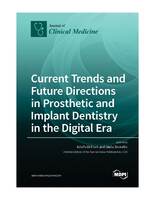Dublin Core
Title
Current Trends and Future Directions in Prosthetic and Implant Dentistry in the Digital Era
Subject
Implant Dentistry
Description
In recent years the dental field has evolved incredibly due to the introduction of digital
technology. Thanks to new devices such as intraoral and facial scanners, different clinical
procedures have been facilitated by reducing clinical steps and operative time [1,2]. The
most changes have emerged in the discipline of prosthetic dentistry, where advances in
technology have provided the ability to realize a crown or an inlay in a few hours. However,
such simplification is not of interest only to the daily clinic approach, but also to diagnosis,
clinical training, and manufacturing methods. The three-dimensional environment allows
clinicians and students to analyze bone quality and quantity, assess the tooth preparation,
and to design a new smile. Moreover, the choice to realize types of dental prostheses
with different techniques has opened a new scenario in dental materials science. New
dental materials have been developed, improving the esthetics, and providing a better
potential for long-term survival and stability. Although the development of material
through subtractive manufacturing presents better mechanical and surface characteristics
than additive manufacturing [3], the future will be additive. This manufacturing method is
an eco-friendly technology, due to the lower environmental impact, the reduced waste of
materials, and the use of recyclable materials. However, the question of whether digital
dentistry is the past, present, or future remains without an answer. A unanimous consensus
is not present among clinicians. Some prefer the use of a conventional workflow or use a
combined workflow, whereas others apply a completely digital workflow. The reasons are
several, but I think that this difference is mainly attributable to the reluctance of clinicians
to change their daily workflow. Where the conventional workflow results in the omission of
some preparation errors, the digital workflow does not. All clinical steps must be executed
with the utmost accuracy. For example, the incorrect management of an interim crown
does not allow the control of many problems associated with digital impressions, such
as localized bleeding, the retraction technique, and the limits of scanners to acquire the
subgingival vertical finish line. Indeed, only high-quality dentistry can take advantage of
digital dentistry, more so than poor-quality dentistry. It is fundamental to remember that
the patient is the most important person in dental treatment, and therefore, must be the
first person that benefits from digital dental procedures. For all clinicians and students, I
give one suggestion: think digital for better daily dentistry.
technology. Thanks to new devices such as intraoral and facial scanners, different clinical
procedures have been facilitated by reducing clinical steps and operative time [1,2]. The
most changes have emerged in the discipline of prosthetic dentistry, where advances in
technology have provided the ability to realize a crown or an inlay in a few hours. However,
such simplification is not of interest only to the daily clinic approach, but also to diagnosis,
clinical training, and manufacturing methods. The three-dimensional environment allows
clinicians and students to analyze bone quality and quantity, assess the tooth preparation,
and to design a new smile. Moreover, the choice to realize types of dental prostheses
with different techniques has opened a new scenario in dental materials science. New
dental materials have been developed, improving the esthetics, and providing a better
potential for long-term survival and stability. Although the development of material
through subtractive manufacturing presents better mechanical and surface characteristics
than additive manufacturing [3], the future will be additive. This manufacturing method is
an eco-friendly technology, due to the lower environmental impact, the reduced waste of
materials, and the use of recyclable materials. However, the question of whether digital
dentistry is the past, present, or future remains without an answer. A unanimous consensus
is not present among clinicians. Some prefer the use of a conventional workflow or use a
combined workflow, whereas others apply a completely digital workflow. The reasons are
several, but I think that this difference is mainly attributable to the reluctance of clinicians
to change their daily workflow. Where the conventional workflow results in the omission of
some preparation errors, the digital workflow does not. All clinical steps must be executed
with the utmost accuracy. For example, the incorrect management of an interim crown
does not allow the control of many problems associated with digital impressions, such
as localized bleeding, the retraction technique, and the limits of scanners to acquire the
subgingival vertical finish line. Indeed, only high-quality dentistry can take advantage of
digital dentistry, more so than poor-quality dentistry. It is fundamental to remember that
the patient is the most important person in dental treatment, and therefore, must be the
first person that benefits from digital dental procedures. For all clinicians and students, I
give one suggestion: think digital for better daily dentistry.
Creator
Adolfo Di Fiore and Giulia Brunello (Eds.)
Source
https://www.mdpi.com/books/book/6466-current-trends-and-future-directions-in-prosthetic-and-implant-dentistry-in-the-digital-era
Publisher
MDPI - Multidisciplinary Digital Publishing Institute
Date
December 2022
Contributor
Dwi Prihastuti
Rights
https://creativecommons.org/licenses/by/4.0/
Format
Pdf
Language
English
Type
Textbooks
Identifier
doi.org/10.3390/books978-3-0365-6050-2

